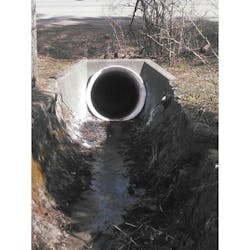No More Singing the Blues Along Highway 61
Louie the King said, “Yes, I think it can be easily done./Just take everything down to Highway 61,” in Bob Dylan’s song, “Highway 61 Revisited.” Dylan, who grew up along the north section of Highway 61, explained in his memoir, “Chronicles,” that it was the main thoroughfare for the music genre known as country blues: “It was the same road, full of the same contradictions, the same one-horse towns.”
While the blues traveled even farther down the Mississippi River, Highway 61 in southern Minnesota has become the Great River Road. A mecca of tourism and a beloved route among cycling enthusiasts, the recently strengthened highway infrastructure means there should be smooth cruising for another 50 years or more, thanks to Inliner Technologies’ method of cured-in-place pipe (CIPP) and other recent roadway improvements.
The Minnesota Department of Transportation (MnDOT) takes a proactive approach to repairing culvert and sewage pipe that transverses its highway infrastructure. The damage caused by a highway collapse because a pipe has completely deteriorated would endanger lives, is expensive to repair and disrupts travel. Using set-aside project funds, MnDOT developed a program to strengthen 42 pipes along 70 miles of Highway 61, starting two miles north of Highway 90 and ending one mile north of Highway 2.
Hugo, Minn.-based underground contractor Lametti & Sons was awarded the $947,000 CIPP contract. With an initial schedule of only 45 days beginning in November 2014, Lametti successfully installed 46 segments of pipe along 70 miles of highway. In total, 3,983 ln ft of sewer and culvert pipe, ranging in size from 12 to 48 in. in diameter, were lined.
Highway 61 is a four-lane divided highway built along the shores of the curving Mississippi River. The hilly terrain along the river’s edge is uncharacteristic for Minnesota. High bluffs along one side of the highway, combined with drop-offs into ditches or railways on the other, meant the installation crew had to overcome multiple challenges.
For decades, excess water poured from the hills and into the culverts, filling them with dirt, rocks and other debris. Workers had to spend extra time cleaning and preparing the existing pipe for the liners. A 10- to 15-ft drop in grade between the upstream and downstream ends of the pipe meant using a larger-than-typical crane to place the installation platform.
Lametti elected to use an air inversion method to place the liners and steam for curing to eliminate both the need to haul large amounts of water to the site and transport wastewater to a treatment facility. “Our crews can do many of these short-run cliff-side culverts in two to three hours, averaging four to five a day,” said Ross Larson, project manager for Lametti. “The fast processing time of steam combined with the simple setup allows us to be efficient.”
The project was scheduled to start in the winter, after the ground had frozen and runoff no longer was an issue. According to Jeffrey Bunch, MnDOT project engineer, the advantages of cold weather installation outweighed the primary disadvantage of needing a longer curing period to maintain the necessary curing temperature during cold weather.
Despite delays to the completion date due to dangerous weather conditions and the extra time needed to clean out the old pipe prior to installation, it was considered a successful project by all. Bunch described the use of Inliner CIPP as an “effortless kind of project.” Both Bunch and Project Inspector Bill Beach stated that the Inliner CIPP pipe products are economical, quick to install, minimally invasive to the terrain and more agreeable to residents who do not want roads blocked.
Download: Here


